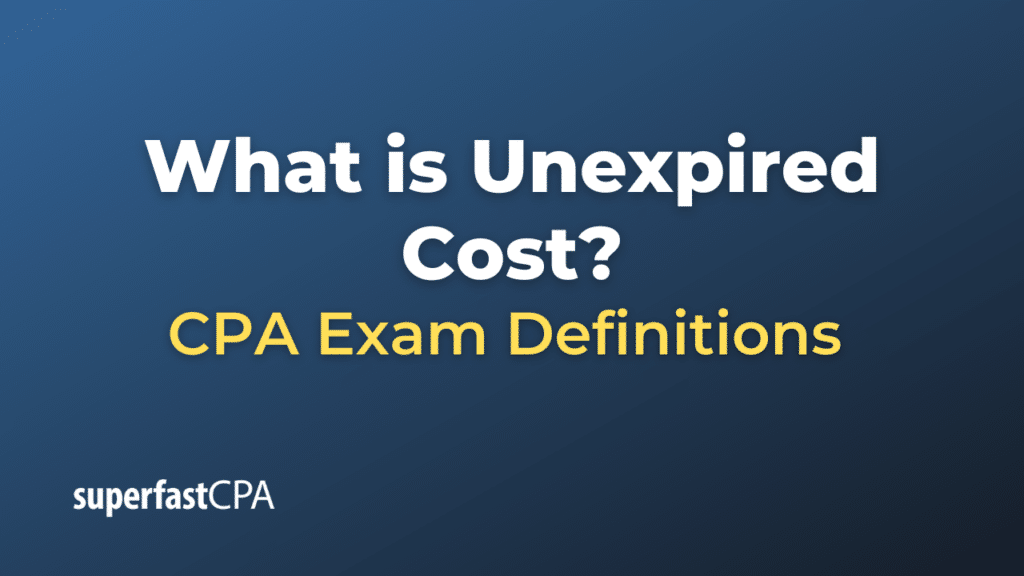Unexpired Cost
Unexpired cost refers to the portion of an asset’s cost that has not yet been used up and is expected to provide economic benefits in future periods. In accounting, assets like property, equipment, and inventory are initially recorded at their cost, and that cost is allocated over the asset’s useful life through depreciation, amortization, or other methods. The unexpired cost represents the remaining balance of an asset’s original cost minus any allocated expenses like depreciation or amortization.
Importance
- Budgeting and Planning: Knowing the unexpired costs of assets can be useful for budgeting future expenditures and planning for asset replacements or upgrades.
- Financial Reporting: Unexpired costs are important in the preparation of financial statements, affecting the valuation of assets on the balance sheet.
- Tax Implications: Unexpired costs can affect the calculation of taxable income, as depreciation and amortization are generally tax-deductible expenses.
- Decision-making : Knowing the unexpired cost of an asset helps in making decisions related to asset disposal, additional investments, and cost control.
Example of Unexpired Cost
Let’s consider a fictional small business, “TechieToys,” which sells remote-controlled drones. To enhance their product offering, they invest in a specialized 3D printer for making drone parts. The 3D printer costs $20,000 and has an expected useful life of 5 years with no residual value.
Initial Accounting:
When the 3D printer is initially purchased, its entire cost is considered as an unexpired cost, as it hasn’t been used or depreciated yet.
- Cost of 3D Printer: $20,000
- Unexpired Cost at the time of purchase: $20,000
Depreciation Method:
TechieToys uses the straight-line method of depreciation, which evenly allocates the cost of the asset over its useful life.
- Annual Depreciation: $20,000 / 5 years = $4,000 per year
Unexpired Cost Over Time:
- After Year 1:
- Depreciation Expense: $4,000
- Unexpired Cost: $20,000 (Initial Cost) – $4,000 (Depreciation for Year 1) = $16,000
- After Year 2:
- Additional Depreciation: $4,000
- Unexpired Cost: $16,000 (Unexpired Cost after Year 1) – $4,000 (Depreciation for Year 2) = $12,000
- After Year 3:
- Additional Depreciation: $4,000
- Unexpired Cost: $12,000 (Unexpired Cost after Year 2) – $4,000 (Depreciation for Year 3) = $8,000
- After Year 4:
- Additional Depreciation: $4,000
- Unexpired Cost: $8,000 (Unexpired Cost after Year 3) – $4,000 (Depreciation for Year 4) = $4,000
- After Year 5:
- Additional Depreciation: $4,000
- Unexpired Cost: $4,000 (Unexpired Cost after Year 4) – $4,000 (Depreciation for Year 5) = $0
Importance:
- Budgeting and Planning: Knowing that the unexpired cost diminishes over time, TechieToys can plan for a replacement 3D printer or upgrades.
- Financial Reporting: The unexpired cost or the book value of the 3D printer would be listed on the balance sheet, affecting the company’s overall asset valuation.
- Tax Implications : The annual depreciation of $4,000 is likely tax-deductible, thus reducing TechieToys’ taxable income.
- Decision-making: By tracking the unexpired cost, TechieToys can make informed decisions about when to sell the 3D printer or invest in a new one.
Understanding the concept of unexpired cost and tracking it over time can be valuable for any business for both financial reporting and operational decision-making.














